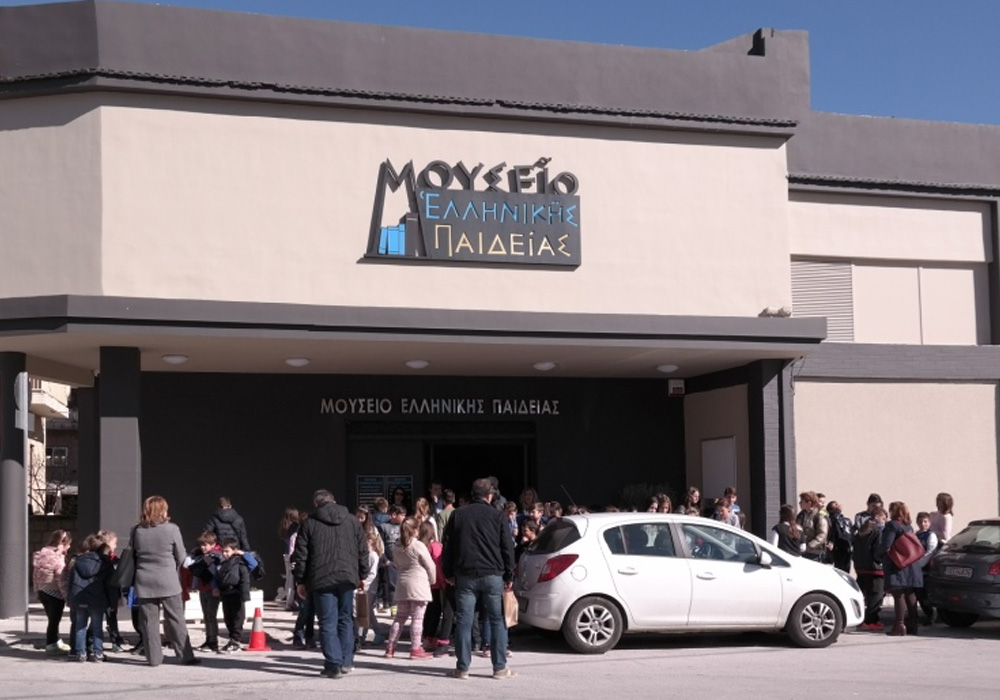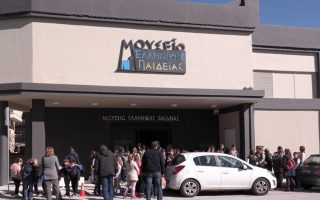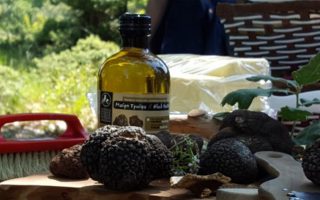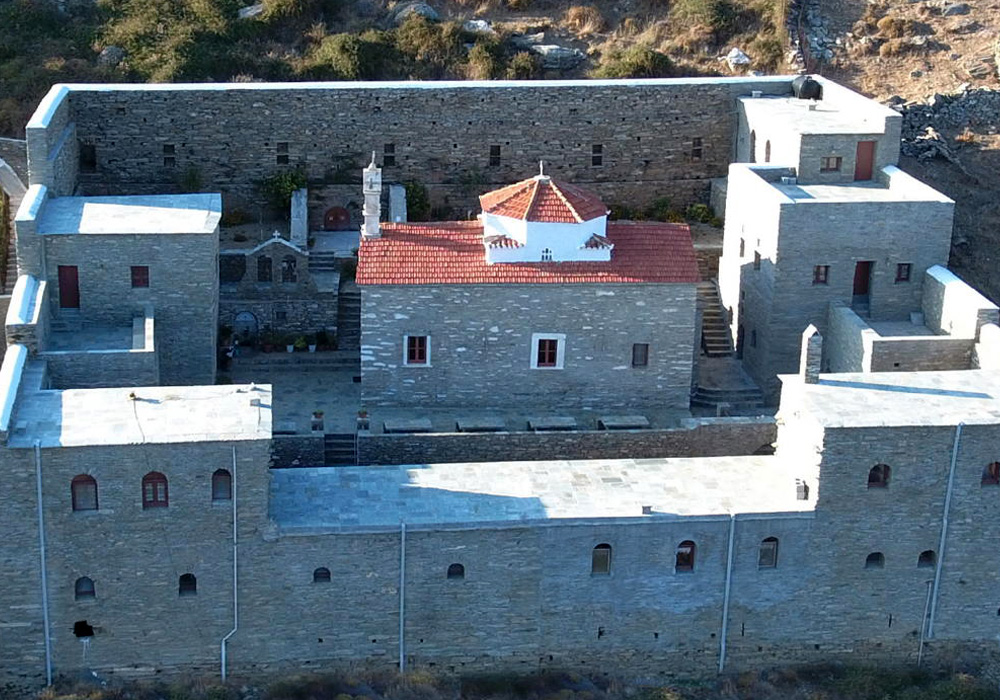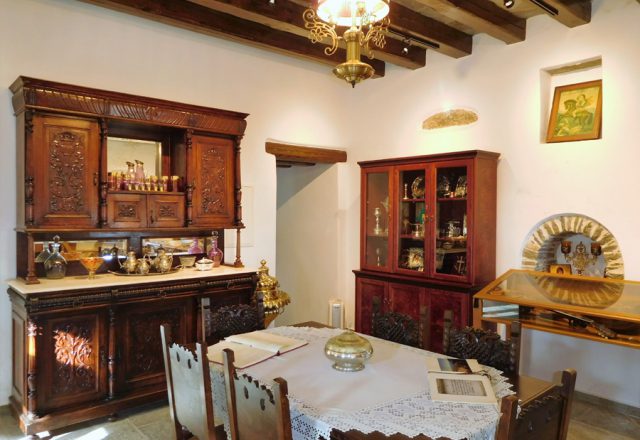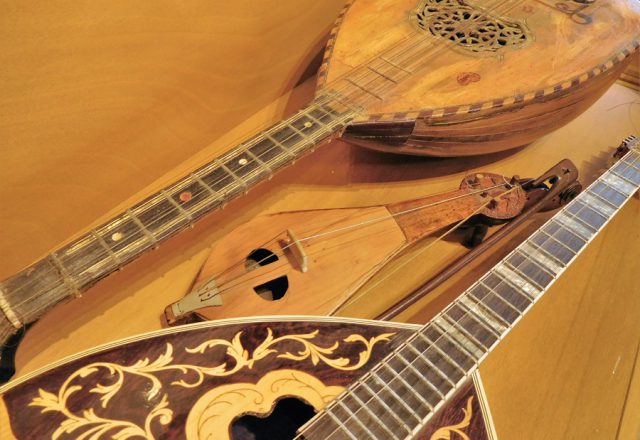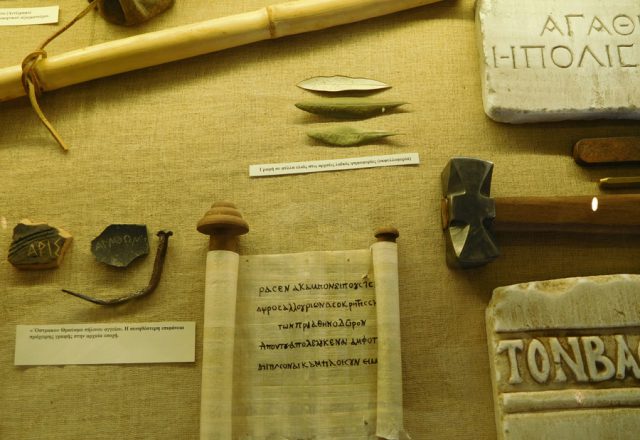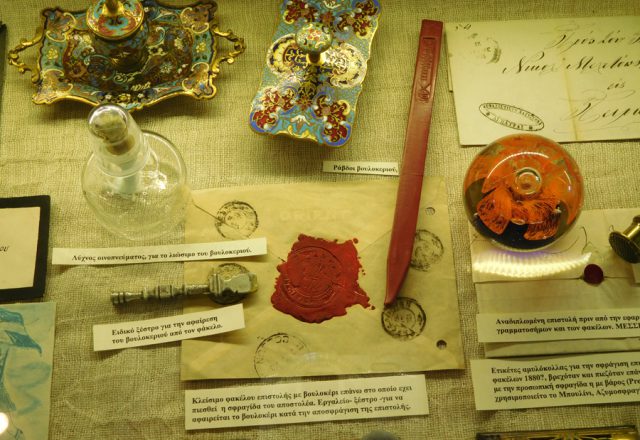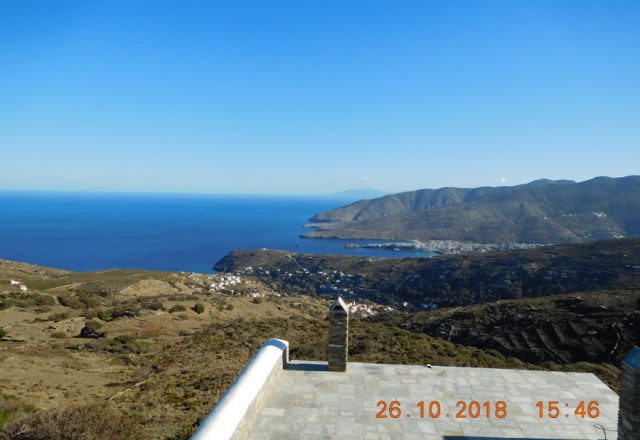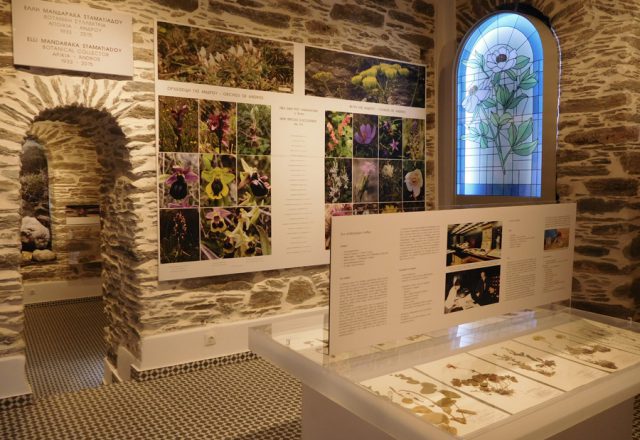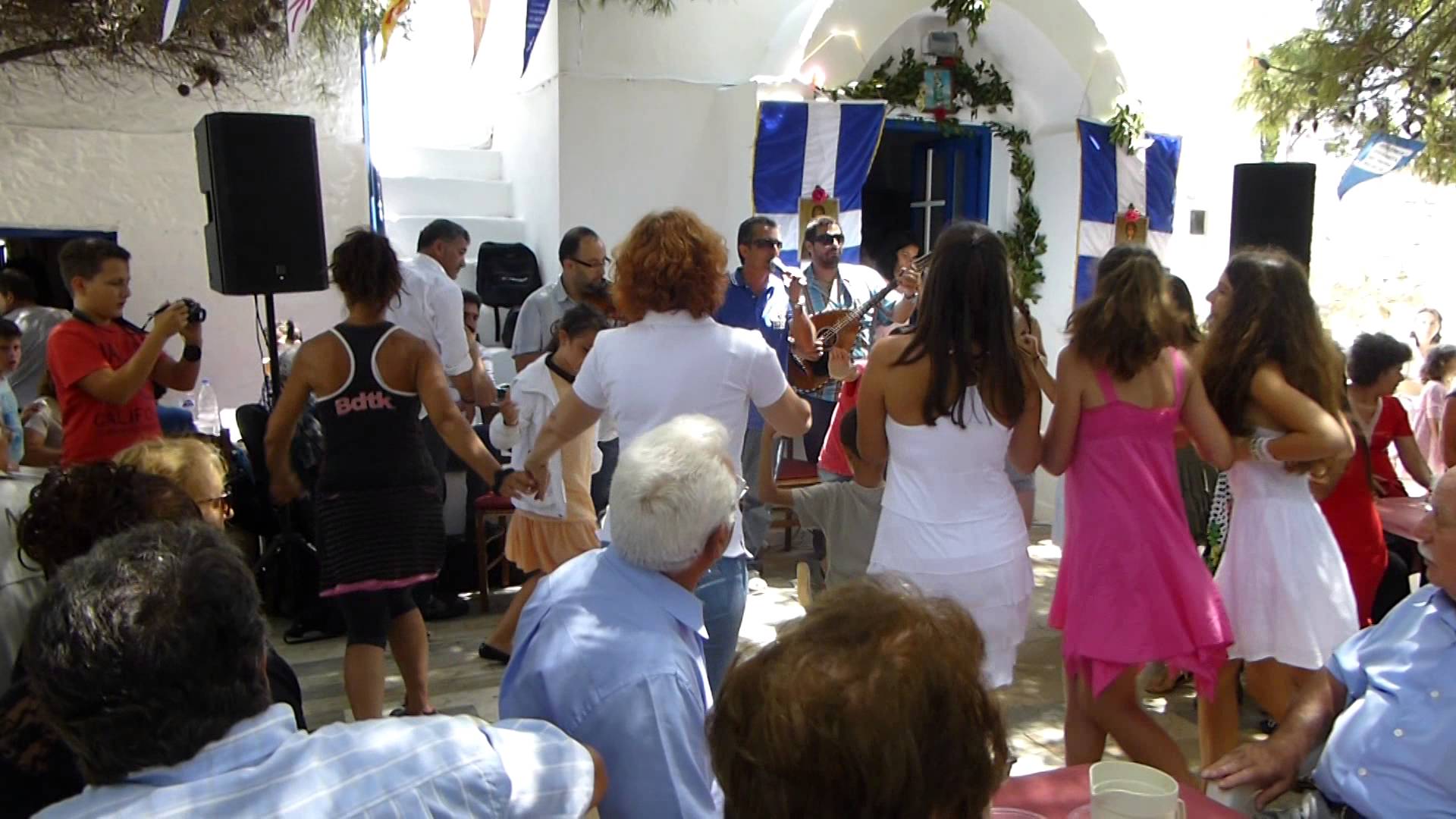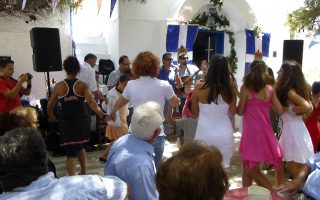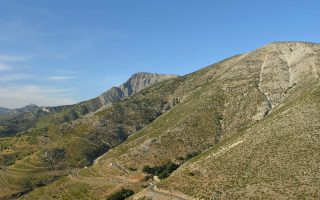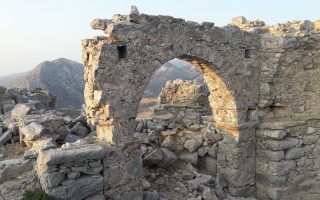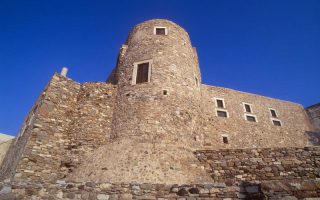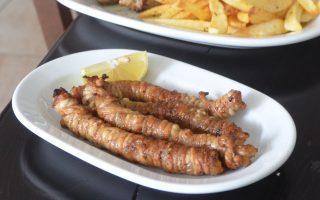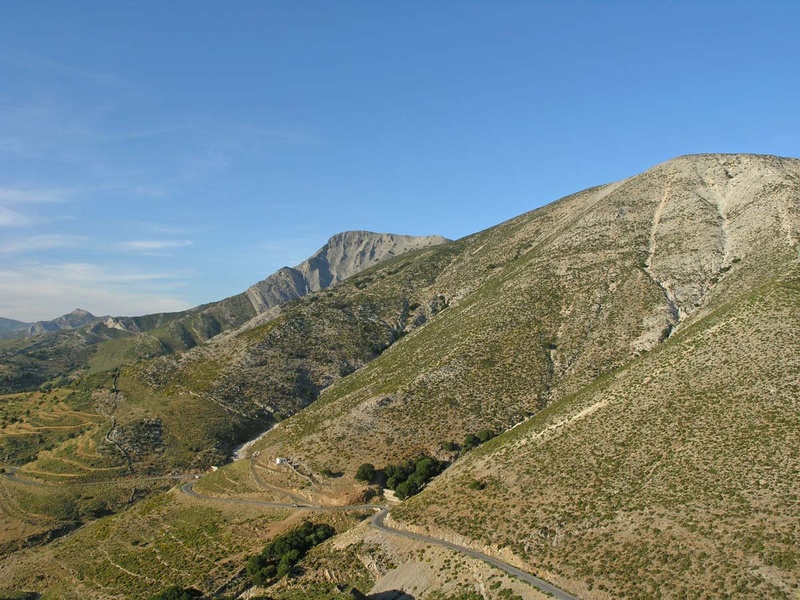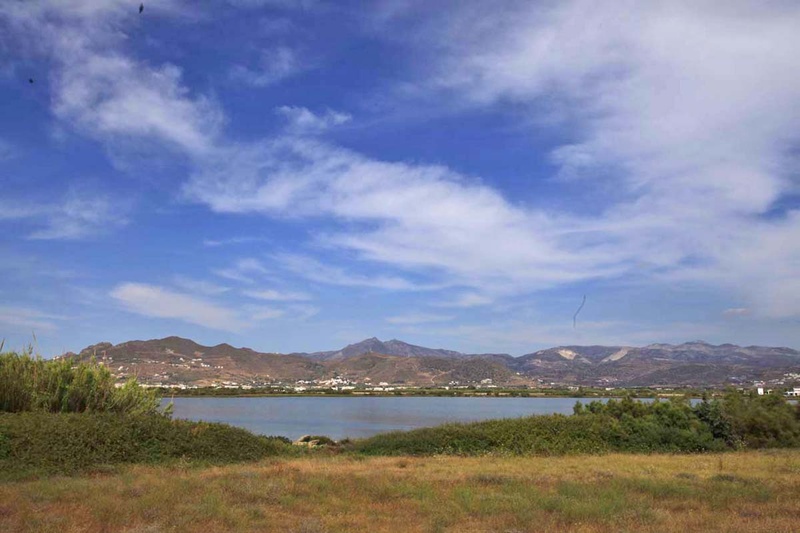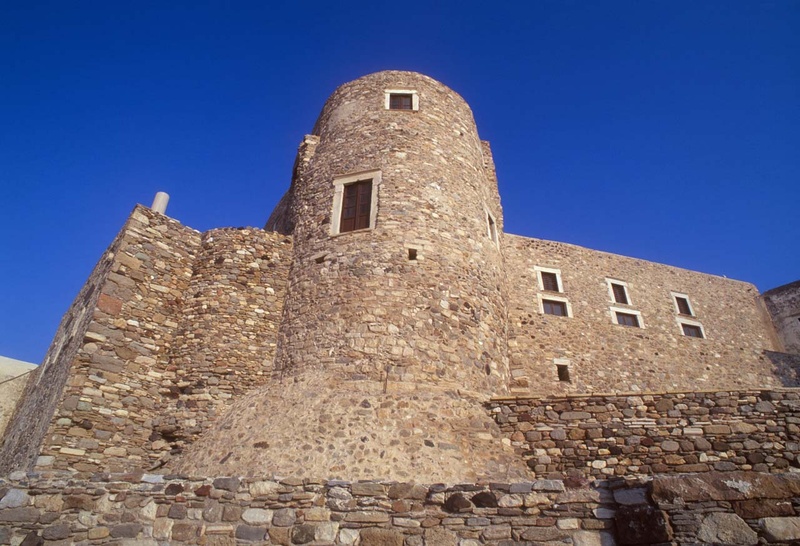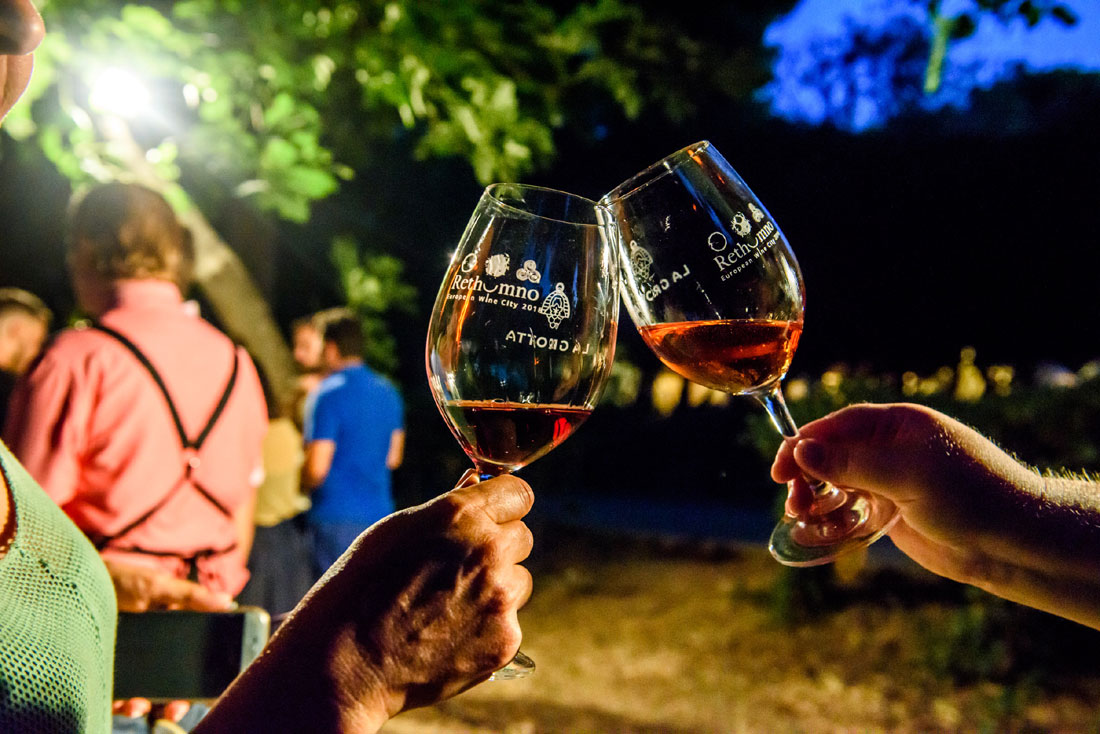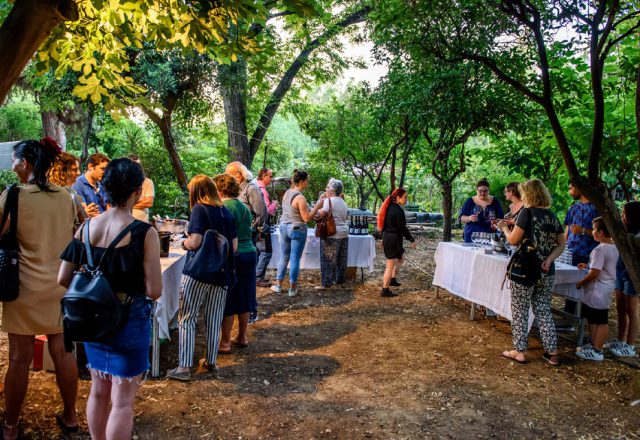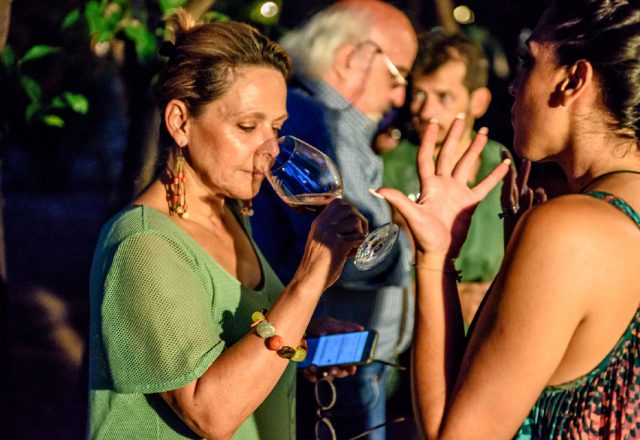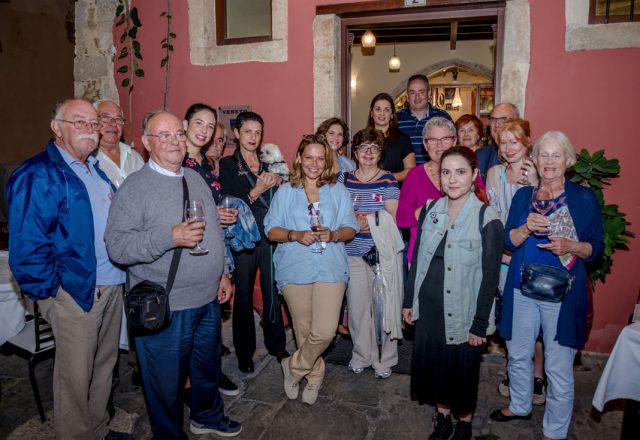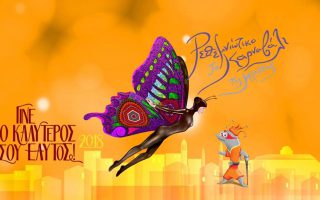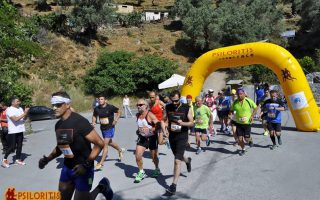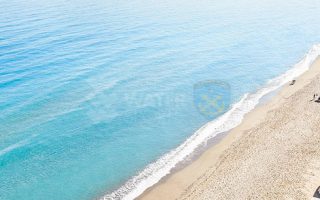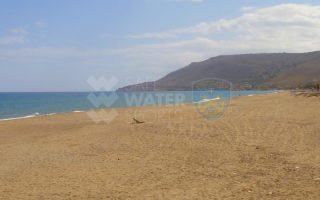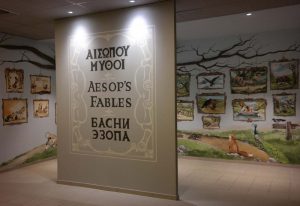 The Hellenic Culture Museum is located in the city center of Kalambaka and houses the private collection of Mr Pavlos Balogiannis in a space of 1000 sq.meters dedicated to the history of Greek education and learning, aspiring to serve its educational and cultural orientation.
The Hellenic Culture Museum is located in the city center of Kalambaka and houses the private collection of Mr Pavlos Balogiannis in a space of 1000 sq.meters dedicated to the history of Greek education and learning, aspiring to serve its educational and cultural orientation.
The museum aims at the preservation,study, promotion and encancement of Greek Education and its values and hopes to establish a strong collection between the visitor and the greek letters and culture in a simple, experidential way and become a cultural center that provides education, learning and science.
The presentation of the collection is perfectly centered to the needs of the modern visitor.
Source: www.bookmuseum.gr
The monastery of Saint Irene was founded in 1780 at Archontas in the village of Apoikia by the Spiridou brothers, both of whom were monks.
At that time it was a nunnery, but in 1833 it was abandoned, due to King Otto’s Royal Degree which demanded the dissolution of the orthodox monasteries, which numbered about 1000 in Greece, with a smalls number of monks or nuns and the confiscation of their properties. Gradually, the buildings around the church collapsed, although the church remained in good condition.
In 2006, Captain Eleftherios Polemis bought the field which included the ruins of the monastery. He and his family renovated the buildings around the church and did maintenance work inside the church, remaining true to the previous architectural form. The renovation took 10 years to be carried out.
Nowadays, the monastery plays a big role in the community. It holds summer camps for children, many of whom are orphans. Furthermore, throughout the whole year it houses the following exhibitions:
- History of writing (Kairis Collection)
- Traditional musical instruments
- Collection of stones, minerals & fossils (Spiros Mpellas collection)
- Elli Mandaraka – Stamatiadou & Flora of Andros
The church (dome basilica) is well worth viewing: it is made from slate with arches, the dome is based on trianglur spheres and the walls are built of traditional stone. Especially notable are the floor with an eagle and the marble ‘iconostasis’ with its flower decoration, dating from 1806.
The museums should be visited and there is a wonderful view of the city of Andros and the coastline with the sea from the Monastery.
The Monastery is open every day from 10:00 – 17:00, including Sundays and celebration days.
Telephone number: 6982038281
For more information, you can find us www.imagiasirinisandrou.gr
E-Mail: imagiaseirinisandrou@gmail.com
Got from: Holy Monastery of Saint Irene
διαβάστε περισσότερα The PALLAS theatre, an Athens landmark, was built in 1931–1932 to be used as a cinema. During the Interwar Period, it was considered the finest cinema-theatre in the Balkans. Designed to obey the style of classicism in line with French models, its monumental entrance is dominated by multicolored marble and an impressive staircase, while the foyer is decorated with walnut paneling, Art Deco stained glass and elaborate mosaics. Its undulating roof was typical of structures of this vintage style. In its original form, the auditorium had a capacity of 2500 seats.
The PALLAS theatre, an Athens landmark, was built in 1931–1932 to be used as a cinema. During the Interwar Period, it was considered the finest cinema-theatre in the Balkans. Designed to obey the style of classicism in line with French models, its monumental entrance is dominated by multicolored marble and an impressive staircase, while the foyer is decorated with walnut paneling, Art Deco stained glass and elaborate mosaics. Its undulating roof was typical of structures of this vintage style. In its original form, the auditorium had a capacity of 2500 seats.
The theatre was fully renovated in the early 2000, while retaining and conserving all its historical elements, and thus turning the Pallas into a contemporary monument. Stage and stalls were completely redesigned, reconstructed and equipped with the latest audiovisual systems to allow for more technically-demanding, contemporary spectacles to be hosted.
The renovated Pallas premiered in November 2006 with Dimitris Papaioannou’s performance “2”, his first project right after The 2004 Olympic Games Ceremonies. Since then, it has hosted productions from all over the world and has receive massive audience attendance and acknowledgement.
The theatre is situated at Voukourestiou Street, near Syntagma (Constitution) Square, one of the most elegant commercial locations in downtown Athens. Housed in the Army Pension Fund building, it is the most suitable venue for all sorts of high-quality productions.
It is currently been managed by Theatrikes Skines S.A
We are delighted to inform you that THEATRIKES SKINES SA offer the opportunity to all English speaking residents or visitors in Athens to expand their cultural scope, as performances at PALLAS TEHATRE now feature English surtitles.
We believe that in Athens, a city featuring more than 1,500 theatrical performances per year and rightly described as the theatrical capital, attending the theater should be an option for everyone, including foreign-language audiences, especially when it comes to Athens’ most central theater. To that end, PALLAS THEATRE, housed in an Art Deco landmark building, which dates back to the 1930s and was fully and respectfully renovated in 2006, has introduced English surtitles during the theater’s main evening performances, Wednesday through Sunday.
‘The Witches of Smyrna’
This season, PALLAS THEATRE presents the much-anticipated theatrical extravaganza ‘The Witches of Smyrna’ by Mara Meimaridi, adapted for the stage and directed by Stamatis Fasoulis, with an all-star cast and production team. Mara Meimaridi’s multiple-award-winning atmospheric novel, which captivated a million readers worldwide and received rave reviews when it was adapted to the small screen by Kostas Koutsomytis in 2005, has now come to the Pallas stage, ready to transport theater-lovers back to late 19th-century Smyrna for a tale of passion, magic, spells, perfumes and love affairs.
You can obtain information about the performances presented in PALLAS THEATRE with English surtitles through http://www.theatrikesskines.gr/performances-with-surtitles
We would appreciate if you would share this information. We remain at your disposal for further information and recommendations.
Please keep in mind:
- Surtitles are in English and Greek. For optimal surtitle visibility, we recommend the seats located in the last rows of the stalls (below 10th row) and in the dress and upper circle.
- Surtitles are available for the main evening show of PALLAS Theater (Wednesday through Sunday)
διαβάστε περισσότερα
The 2019 Epidaurus Festival was announced by the artistic director of Athens & Epidaurus Festival, Vangelis Theodoropoulos, on Monday 22 October, in a press conference held at the Athens Conservatoire.
ANCIENT THEATRE OF EPIDAURUS
21 & 22 June
Oedipus
Directed by Robert Wilson
Co-production: ConversAzioni – Teatro Olimpico Vicenza – Pompeii Theatrum Mundi – Teatro Stabile di Napoli
NATIONAL THEATRE OF GREECE
28 & 29 June
ORESTEIA by Aeschylus
Agamemnon
Directed by Io Voulgaraki
The Libation Bearers
Directed by Lilly Meleme
The Eumenides
Directed by Georgia Mavragani
NATIONAL THEATRE OF GREECE – CYPRUS THEATRE ORGANISATION
5 & 6 July
The Suppliants by Euripides
Directed by Stathis Livathinos
12 & 13 July
Oedipus Rex by Sophocles
Directed by Konstantinos Markoulakis
Co-production: Athinaika Theatra – Municipal and Regional Theatre of Crete
NATIONAL THEATRE OF NORTHERN GREECE
19 & 20 July
Iphigenia in Aulis by Euripides
Directed by Yannis Kalavrianos
26 & 27 July
Comédie-Française
Electra / Orestes by Euripides
Directed by Ivo Van Hove
2 & 3 Aug.
The Clouds by Aristophanes
Directed by Dimitris Karantzas
9 & 10 Aug.
MUNICIPAL AND REGIONAL THEATRE OF PATRAS
Prometheus Bound by Aeschylus
Directed by Stavros Tsakiris
LITTLE THEATRE OF ANCIENT EPIDAURUS
22 June
9th ATHENS OPEN AIR FILM FESTIVAL
Surprise screening
GREEK NATIONAL OPERA – ALTERNATIVE STAGE
28 & 29 June
Kassandra by Iannis Xenakis
Anaparastasis I: The Baritone by Jani Christou
Directed by Alexandros Efklidis
The Day Will Come… by Giorgos Koumentakis
Directed by Ektoras Lygizos
5 & 6 July
Theogony by Hesiod
Directed by Sofia Paschou
12 & 13 July
Griffón DANCE COMPANY
KAOS
Choreographed by Ioanna Portolou
19 & 20 July
Daphnis + Chloe by Longus
Un amore bucolico
Directed by Dimitris Bogdanos
26 & 27 July
Phèdre by Racine
Directed by Efi Theodorou
2 & 3 Aug.
Danaids by Andreas Kalvos
Directed by Natasa Triantafylli
Read more
διαβάστε περισσότεραMusic, dancing with traditional costumes, songs, arts, feasts and festivals are part of the Naxian daily life. The island is famous all over Greece for its rich musical tradition and there are important composers/musicians from Naxos, including Konitopouleoi, Fyrogenides, Stamatonanolides, Vrontogiorgides, Koukoularides, Hatzopouloi. “Kotsakia” (folk poems of two or eight verses that were created in times of joy or sadness and could be instantly sung) are well-known thoughout Greece. In many feasts and festivals organized on the island, it is necessary to have local musical instruments, such as “tzampouna” and “ntoumpaki”, to accompany the celebration.
Especially the mountainous villages of Naxos have a great musical tradition (Apeiranthos, Kinidaros, Koronos, Filoti).
Festivals
Theoskepasti, in Komiaki and Potamia (September 8)
Panagia Drosiani, in Moni (September 8)
Timios Stavros (Holy Cross), in Tripodes and Moni (September 14)
Agios Nikolaos, in Kinidaros (December 6)
Agios Thalalaios, in Thalalaios (May 20)
Panagia Argokoiliotissa, in Koronos (Holy Friday)
Agii Apostoli, in Melanes (June 30)
Agia Kyriaki, in Potamia (July 7)
Agios Prokopios, in Prokopios (July 8),
Agios Nikodimos, in Chora and Glinado (July 14)
Agia Paraskevi, in Kinidaros (July 26),
Sotiros, in Glinado, Damarionas and Koukounochori (August 6)
Panagia, all over the island, especially in Filoti (August 15)
The Novena of the Virgin, in Tripodes (August 23)
Agios Ioannis, in Apeiranthos, Apollonas and Agersani (August 29)
Celebrations
Carnival: The celebration culminates in the last days before Clean Monday and many people are dressed up in memory of the Dionysian festivals. Characteristic figures are “koudounatoi” in Apeiranthos and “foustanellatoi”.
Ai Giannis: Jumping over the fires – to make the evil spirits and the diseases go away – is characteristic of the feast of Agios Ioannis (June 23) in Klidonas. Housewives prepare salty pies, which are considered to have “magical powers”.
Stavrou (Holy Cross): The good harvest is important for the residents of Galanado, who in the feast day of Timios Stavros (Holy Cross, September 14) leave out of the church a few seeds wrapped in a cloth, so as for the priest to bless them.
Trygos (vine harvest): It is a special celebration for the inhabitants of the island in the autumn. The barrels are washed and grapemust is collected to go to the presses. The pressed grapes (tsamboura) left in the barrel are used for raki: Rakitzia is an occasion for people to gather, sing, eat and have fun.
Source: aegeanislands.gr
This is the highest peak of Naxos, usually covered with clouds and named Myti of Za (Nose of Zeus). It has namely the name of Zeus and maybe this was also its name in the antiquity, as they used to worship the father of gods on this very mountain. The archaic inscription carved on a rock in the path that leads to the top of the mountain says “Oros Dios Milosiou” (Mountain of Zeus of Milon), which is an evidence that Naxian shepherds worshiped Zeus also as protector of their flocks, “milon” as they called sheep.
The maximum height of the mountain is 1003m. The cave is found at 600m and it is also connected to the cult of Zeus. An arched gate 2.5m high leads to the magnificent interior of the cave consisting of a chamber with 115m length and 75m maximum width.
The decoration is rich and involves impressive stalactites and stalagmites, boulders and stone clusters. In the highest part of the cave there are two stalagmites named “Papa” and “Papadia”, as well as the so-called “Agia Trapeza”. The cave was explored in 1962 by Anna Petrocheilou. Excavations carried out in the period 1985-86 and in 1994 brought to light important findings from the neolithic to the classical and Roman times, many of which are exhibited at the Archaeological Museum of Naxos. They have also found tools made of obsidian and vertebrate bones.
Info
– During the Turkish rule, the cave was used as a shelter but also as a church.
– To visit the cave, start from the village Filoti (there are signs). The main part of the route is on foot and you will need to carry strong light torches.
Source: aegeanislands.gr
The small wetlands, salt marshes and dunes of Naxos are a haven for birds, fish and reptiles. The most important wetland is that of Alyki which comprises a large lake southwest of the airport runway. It is the largest salt lake in the Cyclades and retains enough water. The vegetation includes reeds, aquatic plants and clumps of cedar trees. 166 bird species have been observed and it is enlisted in the protected areas of NATURA 2000 network.
Four wetlands of the island have been also included in the list of small island wetlands of up to 80 acres, of the Ministry of Environment. According to the Presidential Decree of 2012, the marsh in Pyrgaki, the mouth of Skoulikaria springs in Ammitis, the marsh of Agiassos and the marsh of Kalandos joined the list among 380 small wetlands and came under protection.
Source: aegeanislands.gr
This is a very important castle, built on a steep hill in the fields of Sangri and Agiassos. According to researchers, it took its name after the abundant “apaliries”, a kind of bush that sprouts there. It was erected in the first years of the Byzantine era, though probably there was already a fortification in the antiquity, because part of the wall is prehistoric. It was abandoned in the 13th century with the arrival of the Venetians. When Sanoudos came to the island, the castle was dominated by Genoese pirates. In order to force his men to conquer the castle, he burnt his galleys, so the soldiers had no other choice: drive out the Genoese and take the castle or die. After five weeks of siege, the Venetians of Sanoudos took over Apaliros castle and chased away the pirates. Sanoudos took the island and founded the Duchy of the Aegean.
Nowadays a large part of the castle strong walls is still preserved along with some towers, bastions, cisterns. Apart from the remains of houses the two-aisled church of Agios Georgios with a dome and beautiful architecture is also preserved. Some researches attribute it to the 7th-8th century. There are also other churches in the castle and climbing up there is a unique experience, as it offers an open view of the south side of Naxos.
Source: aegeanislands.gr
Today about 30 towers are preserved in the countryside of the island. They have been built by feudal Venetians in particular (and other Latin nobles) who used them as a base to exploit the real estate of the field they held. Their defensive line included battlements, murder holes, turrets, huge doors and small windows to protect the defenders. They were made of stone and had many floors and thick walls.
Bazeos Tower
It is located right outside Sangri and stands out thanks to its architecture and excellent restoration it has undergone. Every summer it hosts Naxos Festival, one of the most significant cultural events of Cyclades.
Fortified with tall walls, turrets and small windows, the tower was built around 1600 but underwent some changes over the time to take its current form in 1789. It first housed the monastery of Timios Stavros (Holy Cross), which was abandoned at the beginning of the 19th century and in 1834 it became a property of the newly founded Greek state. For many years potters had their workshops in this tower. At the end of the 19th century, the property was sold to Bazeos or Bassegio family, members of which are mainly found in Italy and Brazil. Its owner, Georgios Marios Bazeos, is the last descendant in Greece and vice-president of “Aion” association.
Tower of Ypsili
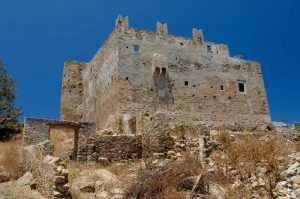 Starting the route from Chora to Apollonas, you will see the tower of Ypsili, or tower of Ypsilotera, or monastery of Ypsilotera, which is open to visitors. It was once a fortified monastery; the katholikon and the impressive frescoe, the towers, the murder holes etc are still preserved. It belonged to Kokkos family (there is an inscription “Iakovos Kokkos 1600”). The monastery was a revolution centre at the time of Naxos people uprisings against the oppression of Latin nobles.
Starting the route from Chora to Apollonas, you will see the tower of Ypsili, or tower of Ypsilotera, or monastery of Ypsilotera, which is open to visitors. It was once a fortified monastery; the katholikon and the impressive frescoe, the towers, the murder holes etc are still preserved. It belonged to Kokkos family (there is an inscription “Iakovos Kokkos 1600”). The monastery was a revolution centre at the time of Naxos people uprisings against the oppression of Latin nobles.
Tower of Belonia
Leaving the town and taking the main road to Galanado (4km away from Chora) and crossing Livadia of Naxos, you will pass by the well-preserved tower of Belonia which was built before 1610. In its interior there is the chapel of Agios Ioannis, both catholic and orthodox, which is rare to see.
Other towers:
KRISPI-GLEZOS TOWER (Chora)
DELLA ROCCA BAROZZI TOWER (Chora)
BAROZZI TOWER IN CHALKI
MAKROPOLITIS TOWER IN KERAMI
TOWER OF MPARDANI AND ZEVGOLI IN APEIRANTHOS
Source: aegeanislands.gr
Rethymno is celebrating the award of European Wine City 2018!
Great news for wine-lovers! Rethymno is celebrating the award of European Wine City 2018 by RECEVIN European Network, opening thus a new page for wine experience and wine-tourism.
Wine has always been a very important part of the daily life and the culture of Cretan people. It is the signature and seal of friendship in social gatherings and an indispensable element in the famous Cretan diet. It is also a symbol of composition, continuity, coexistence and harmony in our relation with the earth, the natural environment and other people.
The fertile soil, the sun and many years of experience, have made Cretans know how to produce wine artfully. The local producers, based on the high quality of the indigenous varieties, such as the white-Rethymnian Vidiano and the red Liatiko, among 11 other original Cretan varieties, and by combining the tradition with the modern know-how, continue to produce an excellent raw material.
This year’s Cretan Diet Festival (1-7 July 2018), was oriented towards wine and its important role in gastronomy: wine-tastings, wine-pairings with the famous Cretan cheese and other Cretan products, seminars and wine classes, recipes based on wine, finger food pairing, back to back tastings, special restaurant menus, and many other special events have been planned, in order to make locals and visitors have an exquisite wine experience, full of music and fun!
Apart from the Cretan Diet Festival, many cultural and culinary actions are planned, both for professionals and the public, throughout the year: you can follow a wine-route, visit a winemaker, taste special cocktails based on wine and served in the best bars of the city, attend art events and exhibitions inspired by wine’s journey throughout the centuries and explore the enchanting process of wine-making through seminars, workshops and conferences.
Certainly Rethymno is not only a vacation place to come and visit but a safe destination full of cultural and nature experiences, with its clean sea and its unspoiled environment. The beautiful landscape, the vibrant small villages, the hospitality and the numerous options for filling the agenda of your visit, make the city the ideal all-season destination.
And this year, Rethymno will be the meeting point for both, foodies and wine-lovers! Don’t miss the chance to be part of the celebration!
For more information:
facebook: Rethymno European Wine City
instagram: @rethymnowinecity
YouTube: Rethymno Wine City

